In 2008 for the first time Allis shad larvae were stocked into the Rhine and some tributaries in the German federal states North Rhine-Westphalia and Hessen. In order to achieve a self-sustaining Allis shad population in the Rhine it is required to continue the stocking measures for a long-term and at least for 15 years.
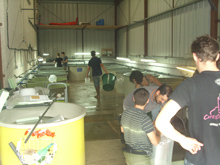 Photo: A. Scharbert
[ Enlarge photo]
Photo: A. Scharbert
[ Enlarge photo]
After the experiences made in shad reintroduction programs in the USA, this time-frame is at least required to found the basis for a stock of adults being large and robust enough to produce enough off-spring to build a self-sustaining population on the long term. Thanks to the integration into the LIFE+ project, the financial basis for the production of 1.5 to 2. Mill. Allis shad larvae per year and the stocking of the Rhine are ensured for the period from 2011 to 2015. The techniques for mass-breeding and marking of shads as the basis for the stocking program have been developed during the previous LIFE project. With the installation of the Allis shad fish farm in Bruch additional knowledge was put into practice and the frame-work for the production of shads on the required scale was guaranteed. These infrastructures will be further utilized for the purposes of the LIFE + project.
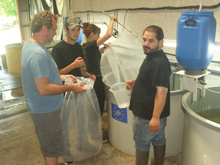 Photo: A. Scharbert
[ Enlarge photo]
Photo: A. Scharbert
[ Enlarge photo]
The techniques of shad breeding and marking were further developed in the recent years and the net larval production (in terms of larvae per gender) was increased. In the frame of the LIFE+ project eggs obtained from the Allis shad fish farm in Bruch will be transported to a German fish farm, incubated and the larvae after getting marked will be stocked into the Rhine system. French experts from the project partner MIGADO who direct and operate the fish farm in Bruch will share their knowledge and experience and transmit it to interested fish farmers in a workshop which will be held in 2013. The objective is to establish breeding techniques and know-how outside of France and to raise a competence centre for shad breeding culture in the Rhine system.
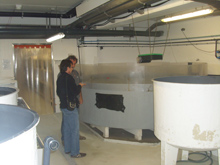 Photo: A. Scharbert
[ Enlarge photo ]
Photo: A. Scharbert
[ Enlarge photo ]
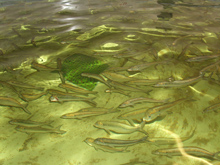 Photo: A. Scharbert
[ Enlarge photo ]
Photo: A. Scharbert
[ Enlarge photo ]
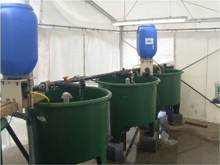 Photo: A. Scharbert
[ Enlarge photo ]
Photo: A. Scharbert
[ Enlarge photo ]
Ex situ stocks have already been proofed to be a useful tool for conservation and reintroduction purposes in conjunction with other migratory fish species, like Atlantic sturgeon (Acipenser sturio) or salmon (Salmo salar). The keeping of fish in captivity and the conditioning until the onset of maturity, provides the advantage that obtaining of sexual products for artificial reproduction purposes can be achieved without exploring the pool of adult fishes from the wildlife. The progeny from wildlife populations kept in captivity can be regarded as a living gene bank in which genetic information can be saved even when the natural population becomes extinct. Finally by transferring of returning adults to a river system (i.e. the Rhine) or their off-spring to ex situ stocks, characteristics of adaptation process to the specific environment of the river system to which the fish are introduced can be selected.
Concerning Allis shad no experiences with regard to conditioning fish in captivity or reaching maturity under these conditions exists so far. In 2008 a batch of shad larvae bred in the Cemagref facility in St. Seurin was transferred to the Aquarium La Rochelle in France for experimental purposes, i.e. to analyze the growth of Allis shad in captivity. They are kept under Sea water conditions like their conspecifics in the wildlife for more than three years. Some of these pre-adult Allis shads are exposed in a public aquarium together with Sardines and Anchovies. The preliminary experiences made the in La Rochelle Aquarium serve as a basis for the installation of a pilot facility for an Allis shad ex situ stock in Germany in order to increase the knowledge on such techniques and to optimize the conditions of keeping.
Since Allis shad hardly tolerate temperatures below 10°C and prefer less cool areas in the Sea during winter, keeping of Allis shad in captivity requires the ambient water to get heated. Since the location originally envisaged for the construction of the pilot facility, a power plant, could not be put into practice, an alternative location needed to be found on very short notice, since the objective of the action to be able to have some adults in stock at latest in 2015 (on average female Allis reach maturity after an age of five years) it was required to transfer larvae bred in France at latest until the end of June of 2011. With the assistance of the partner state Hessen an alternative location for the pilot facility was found on the company grounds of a waste treatment facility of the Hermann Hofmann Group in Aßlar, which provides the requirements, i.e. energy, water, space and utilizable heating effluents. Since the installation of the facility at that spot required higher investments than calculated for the original site, a way to cover the additional costs needed to be found before the implementation of the facility could start. This was realized by making a an eco-point account of the Hermann Hofmann AG for compensatory environmental measures was utilized for the purpose of species conservation measures with the support of the district government of Giessen, in this case the conservation of the Allis shad. Just in time a provisional facility for keeping young shads was planned and installed by the Danish expert Per Thuesen in June 2011 a few days before the last batch of larvae produced in Bruch for the 2011 shad season was delivered. This was only possible thanks to the involvement and assistance of the staff of the recycling facility.
In the course of 2011 the actual ex situ stock facility will be installed and the young shads transferred to this artificial Sea water environment. The experiences gathered in the pilot facility in Asslar and in the Aquarium La Rochelle shall be used for future shad ex situ stock facilities.
Hormone physiological, histological and anatomical studies carried out with the shads from the La Rochelle stock, shall provide data on the optimization of the keeping conditions with regard to growth and maturation of the shads. Amongst other questions by this means the effects of changing ambient conditions (salinity, temperature, current, forage etc.), which are in the wildlife accompanied by the migration of the shads from the Sea to the Estuary and from there to the rivers, shall be simulated and their effect on the maturation and the fertility of the shads will be assessed.
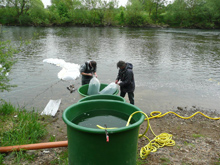 Foto: St. Staas
[ Bild größer]
Foto: St. Staas
[ Bild größer]
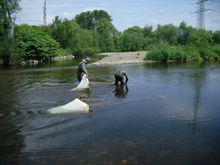 Foto: A. Scharbert
[ Bild größer]
Foto: A. Scharbert
[ Bild größer]
The project on the reintroduction of the Allis shad to the Rhine system is bases on the IUCN criteria for the reintroduction of species, which inter alia implies, that feasibility studies on the general framework for projects prospects, such as the target species’ historical and recent distribution, the availability and accessibility of essential habitats for a sustainable establishment, need to be conducted in the run-up of the project. Furthermore it is necessary to conduct monitoring studies in order to make the progress and the success of the project measurable.
On these grounds, the stocking measures in the Rhine system are conducted by fisheries experts, which parallel carry out surveys and studies on the shads post-stocking behavior and their spatio-temporal habitat utilization. These investigations aim on the evaluation of the stocking sites and to improving the stocking measures in order to successively enhance the survival rates of the young shads. In addition to the studies on the habitat utilization of the YOY shads in the Gironde tributaries, these studies shall help to close the gap of knowledge on the role of freshwater habitats for the recruitment, and to make the results usable for the species conservation.
In the autumn of 2010 YOY Allis shad coming from the same years stocking measures could be proofed to migrate downstream on the Rhine towards the Estuary for the first time. These first records of juvenile shads since the species had become extinct in the 1940ies, not only demonstrate that the projects strategy was successful and that the way of stocking was apparently well suited to ensure a sufficient survival, but that the young shads in the Rhine in its current state and despite the anthropogenic over-imprinting are able to grow into juveniles and show the typical migratory pattern with a shift from the freshwater towards the estuarine regions.
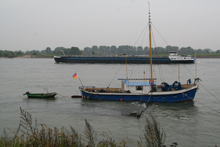 Photo: Ewald Braun/RhFV
[ Enlarge photo ]
Photo: Ewald Braun/RhFV
[ Enlarge photo ]
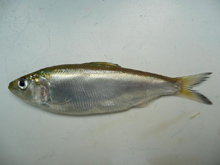 Photo: St. Staas
[ Bild größer]
Photo: St. Staas
[ Bild größer]
Nevertheless, the fact that the young shads were discovered on their seaward migration is thanks to the professional fisher man Rudi Hell, who continues the long tradition of stow-net fisheries. Comprehensive and extensive monitoring studies which would be necessary to be capable to detecting or even more to quantifying the numbers of young shads in the mighty river Rhine, cannot be covered from the project budget. Hence reports on shad by-catches by professional and also recreational fisher man and anglers are urgently required to get an impression of the migratory routes and phases, to be able to take protective measures, i.e. at hydropower plants. We therefore appeal to stakeholder groups to urgently forward information on shad records to the project management. Particularly in the Dutch Delta Rhine area, where the young shads assemble before emigrating to the Sea, and where still quite many professional fishermen practice fyke-net fisheries, it seems rather probable that young shads will be caught incidentally. In order to make sure that YOY Allis shad could be securely distinguished from the closely related and increasingly widely distributed Twaite shad (Alosa fallax) and other young clupeid fish, a determination sheet was developed in Dutch language.
Please contact us when you catch young shads in the Rhine system.
Almost nothing is known about the grazing grounds of Allis shad in the North Sea. However, with regard to the intensity of fishing it is rather probable that shads are accidentally caught by professional fishermen or anglers.
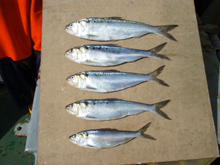 Photo: Michael Janke/AWI
[ Enlarge photo ]
Photo: Michael Janke/AWI
[ Enlarge photo ]
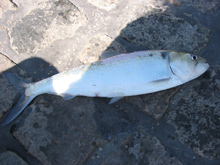 Photo: Lars Ha
[ Enlarge photo ]
Photo: Lars Ha
[ Enlarge photo ]
In order to gather information on the areas where the shads grow until maturity, whether there are shads from the stocking of the LIFE Allis shad project amongst them and to identify from which other river system the fish origin, we appeal to forward information on shad catches in the North Sea to us and if dead shad get into your possession to provide us with the opportunity to obtain the otoliths in order to check these for marks (in case of dissection, please keep dark and avoid direct exposition to UV or sunlight!). Furthermore samples from tissue are of interest, unless they are frozen or stored in Ethanol and can be used for genetic analysis. Explanations on how to securely distinguish Allis shad from the closely related, which has become quite widely distributed in the North Seas coastal areas in the recent years, can be obtained here.
Marine and fisheries research institutes in the North Sea bordering countries were asked to pass on proved Allis shad records to the project management. Additionally the largest German online forum for anglers was asked to inform their users to report shad catches to the project management. By these means a network on shad proofs covering the marine habitats shall be established.
After YOY Allis shad from the stocking measures have been already proved to emigrate from the Rhine to the Sea, proofs from these Allis shads in the marine habitat and particularly returning adults to the Rhine basin would be the overcoming of a high obstacle on the way to a successful reintroduction. Returning adults to the Rhine would proof the fish to be able to overcome the bottlenecks situated in the Delta Rhine area, i.e. the of the Haringvliet dams and the stretches being subject to intensive navigation (Rotterdam harbor, Niewe Waterweg) after having grown into adults within the Sea. Since Allis shad normally reach maturity after having spent 3 to 5 years in the Sea, and the stocking of Allis shad to the Rhine was begun in 2008 with half a million larvae and about 2 Mio. larvae in the following years, an increase of adults Allis shad entering the Rhine system is expected from 2013 onwards.
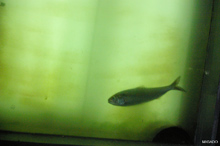 Photo: MIGADO
[ Enlarge photo ]
Photo: MIGADO
[ Enlarge photo ]
With regard to the circuitousness of the Delta Rhine area a representative monitoring of adult Allis shad is hardly possible. Nevertheless, adult Allis shad have been repeatedly documented in the monitoring stations while overcoming the fish passage facilities at the lowest transversal barriers situated on the Upper Rhine near Iffezheim and Gambsheim, which however were identified to be so-called strayers and to origin from the Gironde population. An increase of Allis shad migrating into the Rhine system will thus most probably affect higher numbers of shads detected at the monitoring facilities on the Rhine and the larger tributaries. Although samplings will be carried out in selected sections of the Rhine, it will be essential to receive information about accidental shad catches from the professional and recreational fisheries or carcasses found, as well as observations on spawning shad, in order to gather and to assess information on the shads.
Please contact us and send us photos from possible catches or finds of Allis shad with details on the location, the date and background. We will get in touch with you immediately. Apparently the number of incidental by-catches of Allis shad made by anglers along the coastal areas of the North Sea in Schleswig-Holstein and Denmark has strongly increased from 2010 onwards. Such reports are of great interest, since they provide information on the grazing areas of Allis shad in the North Sea, upon which nothing is known so far. Please contact us immediately if you have caught an Allis shad. We strongly ask for obtaining Allis shad from the North Sea in order to be able to carrying out investigations on their origin.
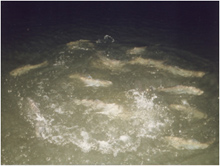 Photo taken from Bagliniere & Elie, 2000
Photo taken from Bagliniere & Elie, 2000
The act of spawning in Allis shad is very conspicuous and noisy, with wild splashing at the water surface and thus audible even over larger distances. Spawning takes place in specific habitats, mainly gravel-banks with moderate depth and current, e.g. at inner-bend banks, when water temperatures are appropriate (16-18°C). The potential spawning habitats being currently accessible to Allis shad in the Rhine and its tributaries were mapped during the previous LIFE Allis shad project. From 2013 onwards, when the first Allis shad from the stocking measures are expected to return to the Rhine for spawning, potential spawning habitats will be surveyed in the relevant time-frame (April-June, when water temperatures are adequate for spawning). With regard to the variety of potential spawning sites along the river course, an identification of actually used spawning sites will be facilitated by receiving tips from stakeholder groups (angler, patrolling water police) and allow to henceforth focus on these for detailed monitoring studies. After a confirmation of young shads coming from natural reproduction, spawning observations would mean to have cleared the highest possible hurdle on the way to a successful reintroduction of the Allis shad within the period until 2015.